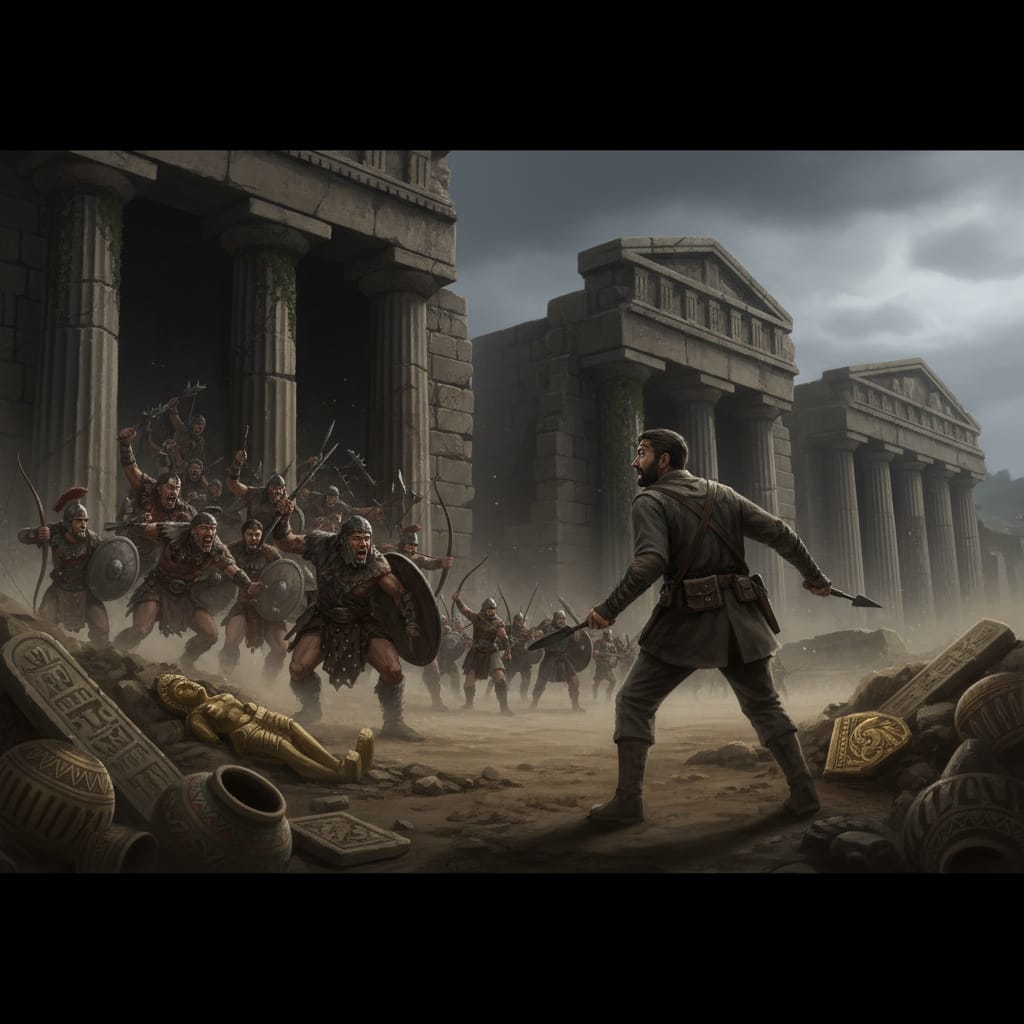The familiar rhythm of a Civilization 6 game often involves a peaceful mid-game pursuit of cultural artifacts. Archaeologists, armed with little more than a trowel and a thirst for knowledge, venture into forgotten lands to unearth the secrets of the past. But what if this seemingly benign activity was fraught with peril? Imagine a world where every archaeological site is a hotbed of barbarian activity, a forgotten battleground where the ghosts of the past are guarded by the fierce warriors of the present. This isn’t just a minor tweak; it’s a fundamental shift in the strategic landscape of Civilization 6, one that would ripple through every era and every victory condition.
Analysis on forums shows that such a change would force a radical rethink of early-game priorities, mid-game expansion, and the very pursuit of a Cultural Victory. The player community suggests that the familiar, often passive, approach to archaeology would be replaced by a new era of militaristic expansion and calculated risk-taking. This guide delves into the strategic implications of this hypothetical scenario, offering a comprehensive analysis of how to not only survive but thrive in a world where the past is no longer buried but besieged.
The New Reality: A More Hostile World
In this altered Civilization 6, the world is a far more dangerous place. The appearance of archaeological sites, once a cause for celebration, would now be a double-edged sword. On one hand, they still represent a treasure trove of culture and tourism. On the other, they are now barbarian encampments in disguise, spawning hostile units and posing a constant threat to your borders.
According to the player community, the most immediate impact would be a significant increase in the number of barbarian encampments on the map. This would lead to a more chaotic and unpredictable early to mid-game, with barbarian hordes posing a persistent threat to trade routes, improvements, and even cities themselves. The familiar strategy of “walling up” and focusing on internal development would become far less viable. Instead, a proactive and aggressive military posture would be essential for survival.
Early Game Survival: The Barbarian Gauntlet
The early game in this scenario is a trial by fire. The increased barbarian presence means that the first 100 turns would be a desperate struggle for survival. Many professional gamers suggest that the standard opening build orders would need to be completely overhauled.
Revised Build Orders: The Primacy of the Military
The traditional Scout-Slinger-Settler opening, while still viable, would need to be augmented with a greater emphasis on military production. A second Slinger, or even a Warrior, would be essential for fending off the inevitable barbarian incursions. The policy card Discipline, which provides a +5 combat strength bonus against barbarians, would become an almost mandatory early-game choice.
A popular strategy is to prioritize the Archery technology. Upgrading your Slingers to Archers as quickly as possible would provide a significant boost to your defensive capabilities. An Archer garrisoned in a city, combined with the city’s own ranged strike, can repel even a determined barbarian assault.
The Art of Barbarian Hunting
In this more hostile world, you can’t afford to be passive. You must become a proficient barbarian hunter. This means actively seeking out and destroying barbarian encampments before they can become a major threat. Your starting Warrior, instead of being used for passive exploration, should be actively patrolling your borders, looking for any signs of barbarian activity.
Analysis on forums shows that the key to dealing with barbarian encampments is to prevent their scouts from reaching your cities. A barbarian scout that spots one of your cities will return to its camp, triggering a massive wave of attacks. Therefore, it is crucial to intercept and destroy these scouts before they can report back.
A common tactic is to use a fast-moving unit, like a scout or a horseman, to “puppy guard” a barbarian encampment. By positioning your unit near the camp, you can intercept any scouts that spawn, preventing them from ever reaching your cities. This allows you to deal with the encampment at your leisure, once you have a more substantial military force.
The Mid-Game Pivot: Securing Your Past
As you transition into the mid-game, the focus shifts from mere survival to actively securing the archaeological sites that are now scattered across the map. This is where the real challenge begins. Each site is a potential goldmine of culture, but it is also a dangerous barbarian encampment that must be cleared before your archaeologists can do their work.
The Archaeological Expedition: A New Kind of Army
The days of sending a lone archaeologist into the wilderness are over. In this new reality, you will need to mount what can only be described as an “archaeological expedition.” This expeditionary force would consist of a combination of military and civilian units.
Many professional gamers suggest a balanced force of at least two melee units, two ranged units, and an archaeologist. The melee units would be responsible for clearing the barbarian encampment, while the ranged units would provide covering fire. Once the site is secure, the archaeologist can then move in to excavate the artifacts.
The cost of these expeditions would be significant. You would need to invest heavily in your military, which could come at the expense of other important infrastructure, such as districts and wonders. This creates a fascinating cost-benefit analysis. Is the potential cultural reward of an archaeological site worth the military investment required to secure it?
The Economics of Archaeology
The decision to pursue an archaeological site would become a complex economic calculation. You would need to weigh the cost of the military units required to clear the site against the potential cultural and tourism benefits of the artifacts within.
A popular strategy is to prioritize sites that are located in strategic locations. For example, a site that is located near a rival civilization’s border could be a tempting target. By clearing the site and establishing a military presence in the area, you could not only gain valuable artifacts but also project power and influence into your rival’s territory.
Another important consideration is the number of charges an archaeologist has. In the standard game, an archaeologist has three charges, meaning they can excavate three artifacts before they are expended. In this new scenario, it would be crucial to maximize the return on your investment. This means carefully selecting which sites to excavate and ensuring that your archaeologist is able to use all of their charges before they are put in harm’s way.
The Cultural Victory: A Pyrrhic Pursuit?
The increased difficulty of obtaining artifacts would have a profound impact on the Cultural Victory path. In the standard game, a well-executed archaeological rush can be a powerful strategy for achieving a Cultural Victory. In this new reality, such a strategy would be far more challenging to pull off.
The Scarcity of Artifacts
The simple fact is that there would be fewer artifacts available. Many archaeological sites would be destroyed by other civilizations or city-states before you have a chance to excavate them. This would make it much more difficult to fill your museums and generate the tourism necessary for a Cultural Victory.
Analysis on forums shows that players would need to be far more strategic in their pursuit of artifacts. The “theming” bonus, which provides a significant boost to tourism for museums that contain artifacts from the same era but different civilizations, would become even more important. This would require careful planning and a bit of luck.
New Paths to Cultural Dominance
While the traditional archaeological rush would be less effective, new strategies for achieving a Cultural Victory would likely emerge. For example, a civilization with a strong military could use its power to “bully” other civilizations into trading their artifacts. A well-timed war could result in the acquisition of several valuable artifacts, giving you a significant boost in the race for a Cultural Victory.
Another popular strategy is to focus on other sources of tourism, such as Great Works of Art, Music, and Writing. While artifacts would still be a valuable source of tourism, they would no longer be the be-all and end-all of the Cultural Victory path. A more balanced approach, one that combines a strong military with a vibrant cultural scene, would be the key to success.
Civilization-Specific Strategies
The challenges and opportunities presented by this new scenario would not be the same for every civilization. Some civilizations would be better equipped to handle the increased barbarian presence, while others would struggle to adapt.
The Warlords: Thriving in Chaos
Civilizations with strong early-game military units, such as Rome, Sumeria, and the Aztecs, would be well-positioned to thrive in this more hostile world. Their powerful unique units would allow them to clear barbarian encampments with ease, giving them a significant advantage in the race to secure archaeological sites.
A popular strategy for these civilizations is to go on the offensive early and often. By aggressively clearing barbarian encampments and archaeological sites, they can not only secure a steady stream of artifacts but also cripple their rivals’ ability to do the same.
The Builders: A Difficult Path
Civilizations that are focused on building and internal development, such as China and Germany, would face a more difficult path. Their lack of early-game military bonuses would make it challenging to deal with the increased barbarian presence.
Analysis on forums shows that these civilizations would need to adopt a more defensive posture in the early game. They would need to invest heavily in walls and other defensive structures to protect their cities from barbarian attacks. Once they have a more established military, they can then begin to venture out and secure archaeological sites.
The Culture Vultures: A New Approach
Civilizations that are focused on culture, such as Greece and France, would need to completely rethink their approach to the Cultural Victory. The traditional strategy of peacefully accumulating artifacts would no longer be viable.
A popular strategy for these civilizations is to form alliances with militaristic civilizations. By leveraging their diplomatic skills, they can convince their allies to clear archaeological sites on their behalf. This would allow them to acquire the artifacts they need for a Cultural Victory without having to invest heavily in their own military.
A New Era of Strategy
The hypothetical scenario of all archaeological sites being guarded by barbarians would fundamentally transform the strategic landscape of Civilization 6. The game would become a more challenging and dynamic experience, one that rewards proactive and aggressive play. The familiar, often passive, pursuit of a Cultural Victory would be replaced by a new era of militaristic expansion and calculated risk-taking.
This change would force players to make difficult choices and to adapt their strategies on the fly. It would create a more engaging and unpredictable gameplay experience, one that would test the skills of even the most seasoned Civilization 6 veterans. While the world would be a more dangerous place, it would also be a more exciting one, a world where the past is not just something to be discovered but something to be conquered.


